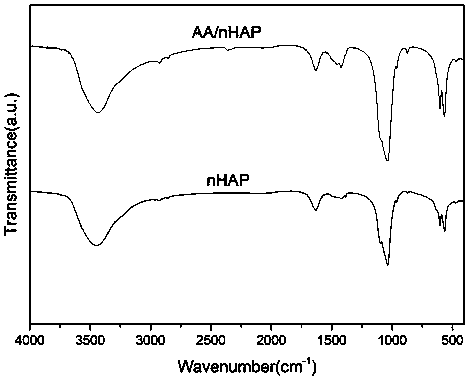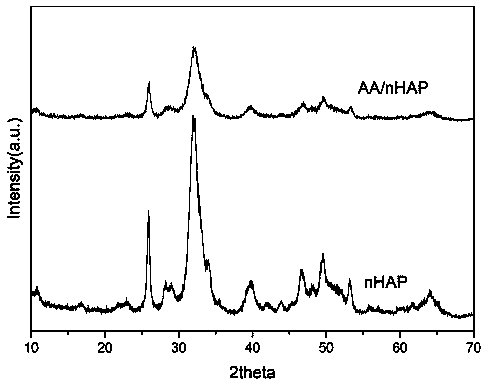Preparation method of modified nano-hydroxyapatite composite material for dental restoration
A nano-hydroxyapatite and composite material technology, applied in dental preparations, dentistry, dental prosthesis, etc., can solve the problems of high crystallinity and structural stability, poor antibacterial performance of nHAP, and unfavorable caries prevention and restoration, etc., to achieve Good antibacterial properties, easy to retain biological activity, and achieve the effect of in situ repair
- Summary
- Abstract
- Description
- Claims
- Application Information
AI Technical Summary
Problems solved by technology
Method used
Image
Examples
Embodiment 1
[0025] (1) Weigh 3.542g of calcium nitrate tetrahydrate and dissolve it in 400ml of deionized water. After fully dissolving, add 1.126g of glycine, 1.727g of proline and 1.997g of aspartic acid to make solution A, and heat it to 37℃ for later use. , wherein the molar ratio of soluble calcium salt to compound amino acid is 1:3.
[0026] (2) Weigh 1.186g of diammonium hydrogen phosphate and dissolve it in 200ml of deionized water to make solution B for later use.
[0027] (3) Use a graduated cylinder to measure 20ml of ammonia water into 200ml of deionized water, and make it into a pH regulator for later use.
[0028] (4) Use a pH regulator to adjust the pH of solution A to 10.0, then slowly drop solution B into solution A (the stoichiometric ratio of Ca / P in soluble calcium salt and soluble phosphate is 1.67), and keep The pH of the reaction solution is 10.0±0.5, and the temperature is 37±1°C.
[0029] (5) Continue to stir for 24 hours after the titration, keep the temperatur...
Embodiment 2
[0033] (1) Weigh 3.542g of calcium nitrate tetrahydrate and dissolve it in 400ml of deionized water. After fully dissolving, add 3.153g of serine and 8.828g of glutamic acid respectively to prepare solution A, heat to 30°C for later use, in which soluble calcium salt and compound The molar ratio of amino acids is 1:6.
[0034] (2) Weigh 1.186g of diammonium hydrogen phosphate and dissolve it in 200ml of deionized water, add 0.0593g of graphene oxide powder, ultrasonically disperse evenly, and prepare solution B for later use, in which the mass ratio of soluble phosphate to graphene oxide is 1: 0.05.
[0035] (3) Use a graduated cylinder to measure 20ml of ammonia water into 200ml of deionized water, and make it into a pH regulator for later use.
[0036] (4) Use a pH regulator to adjust the pH of solution A to 9.0, then slowly drop solution B into solution A (the stoichiometric ratio of Ca / P in soluble calcium salt and soluble phosphate is 1.67), and keep The pH of the react...
Embodiment 3
[0041] (1) Weigh 3.542g of calcium nitrate tetrahydrate and dissolve it in 400ml of deionized water. After fully dissolving, add 0.075g of glycine and 0.067g of aspartic acid respectively to prepare solution A and heat it to 45°C for later use. The soluble calcium salt and The molar ratio of compound amino acids is 1:0.1.
[0042] (2) Weigh 1.186g of diammonium hydrogen phosphate and dissolve it in 200ml of deionized water, add 0.1186g of graphene oxide powder, ultrasonically disperse evenly, and prepare solution B for later use, in which the mass ratio of soluble phosphate to graphene oxide is 1: 0.1.
[0043] (3) Use a graduated cylinder to measure 20ml of ammonia water into 200ml of deionized water, and make it into a pH regulator for later use.
[0044] (4) Use a pH regulator to adjust the pH of solution A to 10.0, then slowly drop solution B into solution A (the stoichiometric ratio of Ca / P in soluble calcium salt and soluble phosphate is 1.67), and keep The pH of the r...
PUM
| Property | Measurement | Unit |
|---|---|---|
| Film diameter | aaaaa | aaaaa |
| Thickness | aaaaa | aaaaa |
| Diameter | aaaaa | aaaaa |
Abstract
Description
Claims
Application Information
 Login to View More
Login to View More - R&D
- Intellectual Property
- Life Sciences
- Materials
- Tech Scout
- Unparalleled Data Quality
- Higher Quality Content
- 60% Fewer Hallucinations
Browse by: Latest US Patents, China's latest patents, Technical Efficacy Thesaurus, Application Domain, Technology Topic, Popular Technical Reports.
© 2025 PatSnap. All rights reserved.Legal|Privacy policy|Modern Slavery Act Transparency Statement|Sitemap|About US| Contact US: help@patsnap.com



